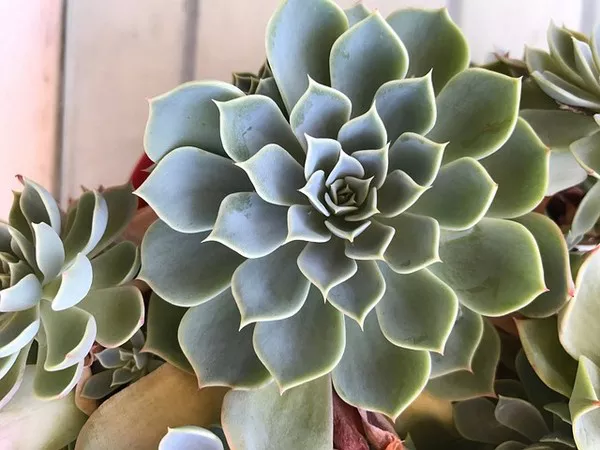Ghost succulents, also known as Graptopetalum paraguayense or Ghost Plant, are a stunning addition to any succulent collection. Their ethereal, silvery-gray leaves arranged in rosettes make them stand out among other succulent varieties. Originating from Mexico, these hardy plants have gained popularity among both novice and experienced succulent enthusiasts for their unique appearance and ease of care.
Propagation Methods
Ghost succulents can be propagated through various methods, including leaf cuttings, stem cuttings, and offsets (also known as pups). Each method offers its own advantages and may be preferred depending on the circumstances.
1. Leaf Cuttings
To propagate ghost succulents from leaf cuttings, begin by selecting healthy leaves from the mother plant. Gently twist the leaves from the stem, ensuring that you include the entire leaf and a small portion of the stem. Allow the cuttings to callus over for a few days in a dry, shaded area to prevent rotting. Once calloused, plant the cuttings in a well-draining soil mix and lightly mist the soil to keep it moist. Avoid direct sunlight until new roots and shoots begin to emerge.
2. Stem Cuttings
Stem cuttings are another effective way to propagate ghost succulents. Using a clean, sharp knife or scissors, cut a section of the stem from the mother plant, ensuring that it is at least 2 inches long. Remove any leaves from the bottom portion of the cutting to expose the nodes where roots will form. Allow the cut end to callus over before planting it in a well-draining soil mix. Keep the soil lightly moist and provide indirect sunlight until roots develop.
3. Offsets (Pups)
Ghost succulents often produce offsets, or pups, which can be separated from the mother plant and planted individually. To propagate using offsets, gently twist or cut the pups from the mother plant, taking care to include some roots if possible. Allow the offsets to callus over before planting them in a suitable soil mix. Water lightly and provide indirect sunlight until they establish themselves.
Preparing the Cuttings
Before planting, it is crucial to allow the cuttings to callus over. This process involves allowing the cut ends of the plant material to dry and form a protective layer, which helps prevent rotting when planted. Place the cuttings in a shaded area with good airflow for a few days until calloused before planting them in soil.
Planting Medium
Choosing the right soil mix is essential for successful ghost succulent propagation. A well-draining mix is ideal to prevent waterlogged conditions, which can lead to rot. A combination of cactus potting mix and perlite or coarse sand provides excellent drainage while still retaining some moisture. Avoid using regular garden soil, as it tends to compact and retain too much water.
Planting and Care
When planting ghost succulent cuttings, ensure that they are positioned in the soil with the callused end down and the leaves or stems above the surface. Water the soil lightly, being careful not to saturate it, as excess moisture can lead to rot. Place the newly planted cuttings in a location with bright, indirect sunlight to encourage root growth and establishment. Avoid exposing them to direct sunlight until they have developed a strong root system.
In terms of care, ghost succulents prefer moderate temperatures ranging from 65°F to 75°F (18°C to 24°C). Water sparingly, allowing the soil to dry out between waterings. Overwatering is one of the most common issues encountered with succulents and can lead to root rot. Additionally, ensure adequate airflow around the plants to prevent fungal diseases.
Troubleshooting
Despite their resilience, ghost succulents may encounter some common problems during propagation. Overwatering is a frequent issue that can cause the roots to rot. To remedy this, allow the soil to dry out completely before watering again and adjust your watering schedule accordingly. If you notice any signs of rot, such as mushy or discolored stems or leaves, remove the affected areas immediately to prevent further spread.
Another issue to watch for is pest infestations, such as mealybugs or aphids, which can damage the plants if left untreated. Regularly inspect your ghost succulents for signs of pests and treat them promptly using insecticidal soap or neem oil.
Additional Tips
Patience is key when propagating ghost succulents, as it may take several weeks for new roots and shoots to develop.
Provide adequate airflow around the plants to prevent fungal diseases and encourage healthy growth.
Consider using a rooting hormone to promote faster root development, especially when propagating from stem cuttings.
Experiment with different propagation methods to find the one that works best for you and your plants.
Don’t be afraid to ask for advice or seek guidance from fellow succulent enthusiasts or online communities.
Conclusion
In conclusion, propagating ghost succulents can be a rewarding experience for plant lovers of all skill levels. By following these methods and tips, you can successfully propagate these stunning plants and expand your succulent collection with ease. With proper care and attention, your ghost succulents will thrive and delight you for years to come.


